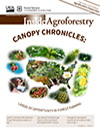Additional Applications
Additional applications are “new twists” to familiar agroforestry practices. These are tree and shrub plantings that can help solve special resource concerns, provide benefits not commonly associated with agroforestry practices, or are plantings used in nontraditional locations like the rural-urban interface or within communities.
Some additional applications include the utilization of wastewater to produce a short rotation woody crop, plantings to help stabilize streambanks and floodplains, windbreaks to mitigate odor from livestock operations, living snow fences to manage drifting snow along roads, practices to provide energy conservation and production, plantings producing edible fruits and nuts, and buffers to reduce noise and support pollinators.
A scientific synthesis by NAC has found that agroforestry practices can provide three key benefits for pollinators: (1) providing habitat including foraging resources and nesting or egg-laying sites, (2) enhancing site and landscape connectivity, and (3) mitigating pesticide exposure.

(USDA Natural Agroforestry Center photo)

(USDA Natural Agroforestry Center photo)

(USDA Natural Agroforestry Center photo)

(USDA Natural Resources Conservation photo)
These types of agroforestry applications can have particular relevance at the rural-urban interface, where they can provide significant environmental benefits while allowing the land to remain economically and socially productive. Agroforestry can also support green infrastructure networks. This connectivity helps filter and reduce storm water runoff, provides travel corridors for wildlife, creates recreational space, and improves air and water quality for the whole watershed. These plantings can also provide locally sourced food. Cumulatively, these functions contribute to the overall health and sustainability of a community and its neighbors.
Additional applications will continually be developed as people find new and innovative uses for agroforestry science and technology.
Additional Applications Publications
Information Sheets
Infosheet

Infosheet

Brochures
Inside Agroforestry
Inside Agroforestry

Inside Agroforestry

Inside Agroforestry

Inside Agroforestry

Inside Agroforestry

So Many Trees To Choose From
DownloadInside Agroforestry

Agroforestry: Part Of A Sustainable Future For Agriculture
DownloadInside Agroforestry

Green Infrastructure: Reconnecting Agriculture And Communitites
DownloadInside Agroforestry

Alley Cropping: 20/20 Vision For Farming's Future
DownloadInside Agroforestry

Spring 2000
DownloadInside Agroforestry

Spring 1998
DownloadInside Agroforestry

Fall 1997
DownloadInside Agroforestry

Summer 1997
DownloadInside Agroforestry

Winter 1994
DownloadInside Agroforestry

Spring 1994
Download
Agroforestry Notes
Research
Research

Temperate Agroforestry Systems & Insect Pollinators: A Review
Download
























